The 1980s was definitely considered a transformative era for cinema.
It was marked by the rise of blockbuster films, horror films, innovative storytelling, and the emergence of influential directors and actors who produced some of the highest-grossing films in the industry. This decade not only redefined popular culture but also left an indelible mark on the art of filmmaking.
One key aspect of ’80s cinema was the birth of the blockbuster phenomenon, but I’ll get into that a bit later.
Althought not the same year, filmmakers like Steven Spielberg, John Hughes, and James Cameron brought their unique visions to the screen. These artists were creating movies that continue to resonate with audiences, even today.
For film enthusiasts, watching iconic ’80s movies offers a masterclass in storytelling, character development, and visual storytelling.
So, if you’re one of the enthusiasts, scroll down!

Key Takeaway
- The 1980s transformed cinema with blockbuster hits, innovative storytelling, and influential directors like Spielberg, Hughes, and Cameron.
- Iconic films like “Blade Runner” set new standards for special effects and infused a sense of nostalgia into modern cinema.
- Memorable classics such as “The Princess Bride,” “The Shining,” and “Stand By Me” explored timeless themes with unforgettable characters.
- Top picks from the era include “Top Gun,” “Dirty Dancing,” “Raiders of the Lost Ark,” and “Back to the Future,” each leaving an enduring impact on audiences and shaping the future of filmmaking.
Defining the ’80s Film Era
Ah, the 1980s!
Or should I say a decade that left an indelible mark on cinema?
Let’s take a walk through the famous 80s cinema.
Firstly, the 1980s was a golden age of blockbuster entertainment, which I’ve hinted in the introduction.
The era birthed larger-than-life action heroes like Arnold Schwarzenegger and Sylvester Stallone (there’s not a chance that you haven’t heard those names at least once in your lifetime, even if you’re a young Gen Z), whose biceps seemed to defy the laws of physics.
This was the era when action films weren’t just movies; they were adrenaline-pumping spectacles, perfectly complemented by classic movies like “Die Hard” and “Indiana Jones.”
Moreover, the ’80s embraced the fantastical.
From “E.T.” to “Back to the Future,” this was a time of imaginative storytelling where the ordinary collided with the extraordinary. Oh, and let’s not overlook the emergence of the modern teen film.
John Hughes became the maestro of coming-of-age tales with films like “The Breakfast Club,” capturing the angst and aspirations of a generation. These movies weren’t just about adolescence; they defined it.
The ’80s also embraced the supernatural and horror genres, birthing franchises like “Ghostbusters.”
The Impact on Filmmaking
Now, how did the ’80s shape contemporary filmmaking?
Films like “Blade Runner” introduced groundbreaking special effects that revolutionized the industry, setting a new standard for immersive storytelling.
Furthermore, the ’80s infused a sense of nostalgia into modern cinema. Filmmakers often pay homage to this era through music, fashion, and storytelling techniques.
One thing’s for sure: the 1980s was a transformative period for cinema, characterized by larger-than-life characters, imaginative storytelling, and a spirit of unbridled creativity.
Top 12 Films of the 1980s
As I’ve said, the 1980s was a decade that redefined cinema. Undoubtedly, it produced a wealth of influential and iconic films across various genres.
This era introduced us to unforgettable characters, groundbreaking special effects, and enduring narratives that continue to resonate with audiences today. So, without further ado, let’s get into it!
The Princess Bride (1981)
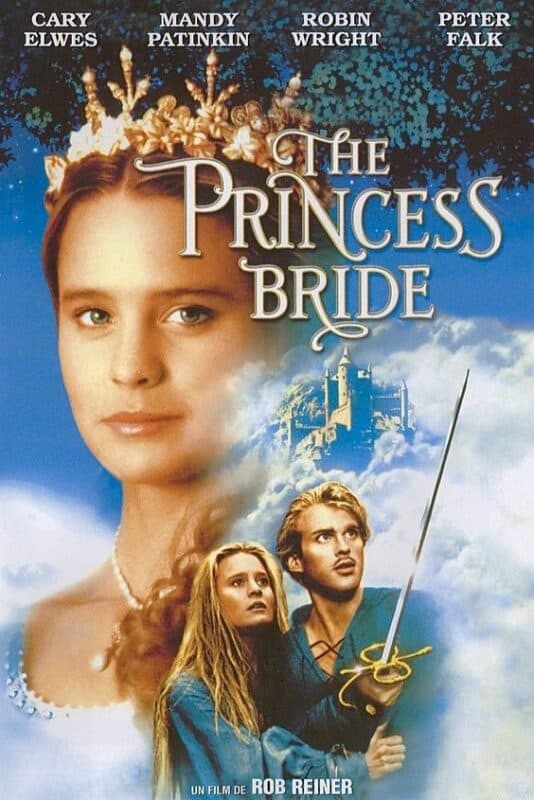
Source: theprincessbride / Pinterest
“The Princess Bride” (1987) is a timeless tale that blends romance, adventure, and humor into a delightful fantasy adventure. Directed by Rob Reiner and based on William Goldman’s novel, the film unfolds as a story within a story, narrated by a grandfather to his skeptical grandson.
What makes “The Princess Bride” truly special is its clever script, filled with memorable quotes and moments of self-awareness that poke fun at classic fairy tale tropes. Rob Reiner’s direction brings a whimsical charm to the story, capturing the essence of a storybook adventure come to life.
The performances are equally enchanting, with Cary Elwes and Robin Wright “bringing to life” the idealistic hero and determined heroine, while the supporting cast brings depth and humor to their roles.
The Shining (1980)
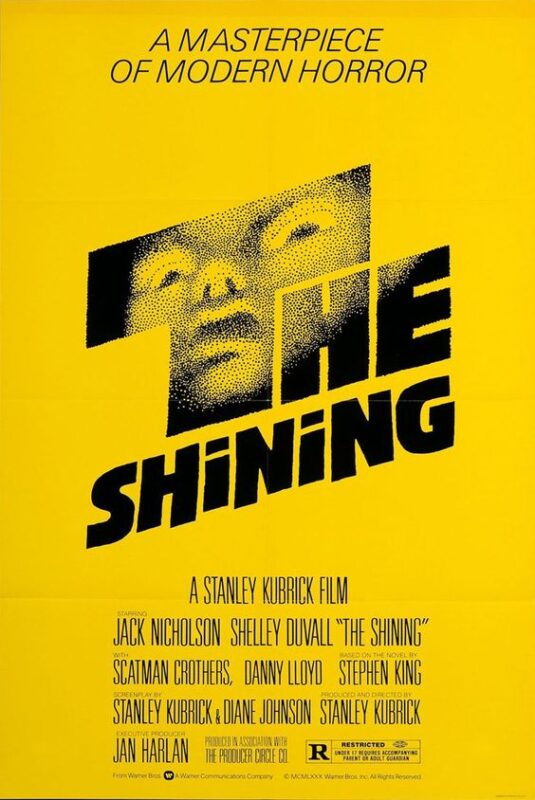
Source: es.99designs.com / Pinterest
Directed by Stanley Kubrick, this film stands as a psychological horror masterpiece adapted from Stephen King’s novel of the same name.
Jack Nicholson delivers a captivating performance as Jack Torrance, a writer and recovering alcoholic who accepts a job as the winter caretaker of the remote Overlook Hotel, nestled in the snowy mountains of Colorado. Alongside him are his wife Wendy and young son Danny, who possesses psychic abilities known as “the shining.”
Kubrick’s flawless direction and visual storytelling create a creeping dread and isolation from the beginning.
The eerie setting, coupled with the haunting score by Wendy Carlos and Rachel Elkind, builds tension and unease, setting the stage for Jack’s descent into madness.
“The Shining” explores themes of isolation, familial tension, and the destructive power of unchecked ambition.
“The Shining” remains a touchstone in horror cinema, celebrated for its artistic merits and profound impact on the genre. Kubrick’s meticulous craftsmanship, combined with Nicholson’s tour de force performance, ensures this chilling tale continues to haunt viewers and inspire filmmakers decades after its release.
Stand By Me (1986)
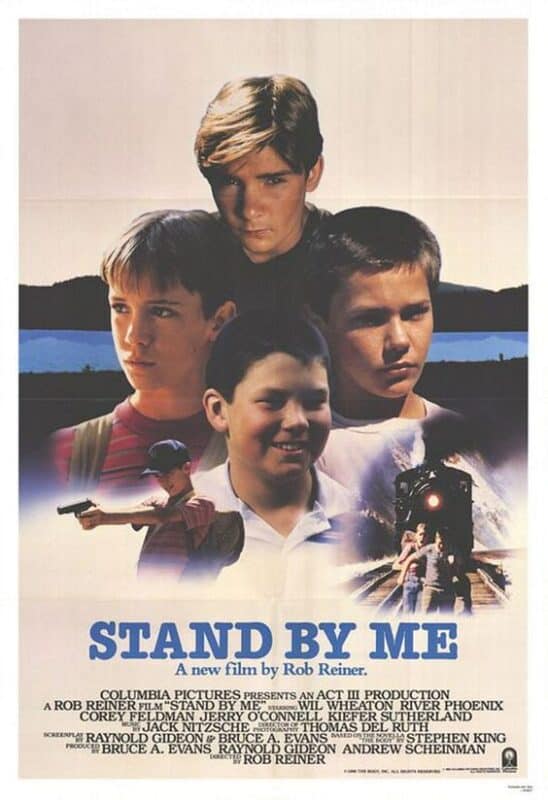
Source: thoughtco.com / Pinterest
Directed by Rob Reiner, this is a coming-of-age drama adapted from Stephen King’s novella “The Body.”
Set in the small town of Castle Rock, Oregon, the film follows four boys: Gordie, Chris, Teddy, and Vern, as they embark on a transformative journey into the wilderness in search of the body of a missing boy named Ray Brower.
Each character is vividly portrayed, with River Phoenix delivering a standout performance as Chris Chambers, a troubled but inherently good-hearted boy with dreams of breaking free from his troubled family legacy. “Stand by Me” explores themes of friendship, loss of innocence, and the passage of time with sensitivity and depth.
“Stand by Me” remains a timeless classic that resonates with audiences of all ages.
It celebrates the bonds of childhood friendship and the profound impact of shared experiences, leaving a lasting impression on those who embark on this emotional journey alongside its endearing characters.
Top Gun (1986)
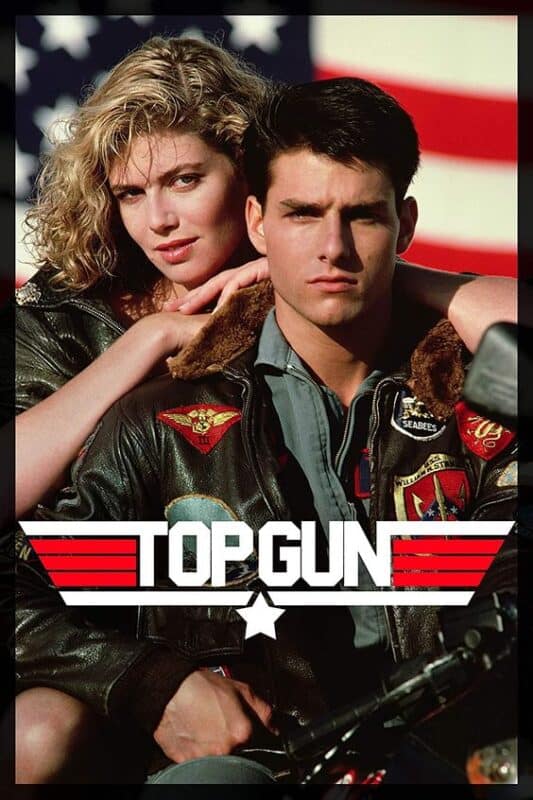
Source: amazon.com / Pinterest
“Top Gun” (1986), directed by Tony Scott, is an electrifying action film that catapulted Tom Cruise to stardom and became a cultural phenomenon of the 1980s.
Set at the prestigious Top Gun Naval Fighter Weapons School, the film follows hotshot pilot Pete “Maverick” Mitchell as he competes to be the best among the best.
At its core, “Top Gun” is not just about action; it’s a character-driven story that delves into Maverick’s journey of self-discovery and growth. Tom Cruise’s charismatic performance as Maverick captures the character’s cockiness, ambition, and vulnerability, while his rivalry with fellow pilot Tom “Iceman” Kazansky adds depth to the narrative.
Beyond the aerial spectacle, “Top Gun” explores themes of friendship, teamwork, and the sacrifices of military service. The film’s romantic subplot between Maverick and civilian instructor Charlie Blackwood adds emotional depth and humanizes the otherwise fearless pilot.
Blade Runner (1982)
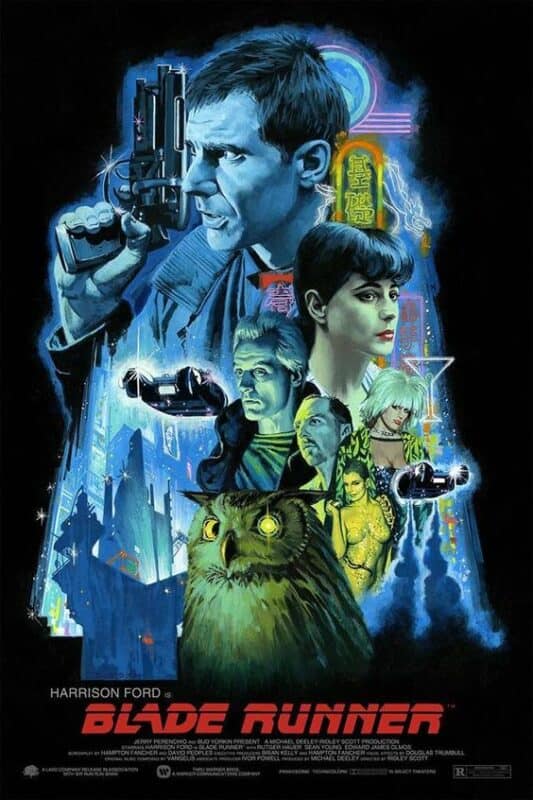
Source: bladefunner.com / Pinterest
“Blade Runner” (1982), directed by Ridley Scott, is a groundbreaking sci-fi noir film that has left an indelible mark on the genre. Set in a dystopian future Los Angeles, the film follows Rick Deckard, a retired “blade runner” brought back into service to track down and “retire” rogue replicants: bioengineered humanoids with limited lifespans.
Ridley Scott’s visionary direction and mesmerizing visuals create a hauntingly atmospheric world filled with neon-lit streets, towering skyscrapers, and perpetual rain. The film’s production design, influenced by cyberpunk aesthetics, remains iconic and has inspired countless works of science fiction.
“Blade Runner” explores profound philosophical themes, including what it means to be human. As Deckard encounters replicants like the enigmatic Rachael (Sean Young), he grapples with questions of identity, morality, and empathy in a world where artificial beings challenge the boundaries of existence.
Since its release, “Blade Runner” has garnered a cult following and influenced generations of filmmakers, setting a new standard for visual storytelling in science fiction cinema.
“Blade Runner” remains a landmark achievement, challenging perceptions and pushing the boundaries of cinematic imagination.
The Blues Brothers (1980)
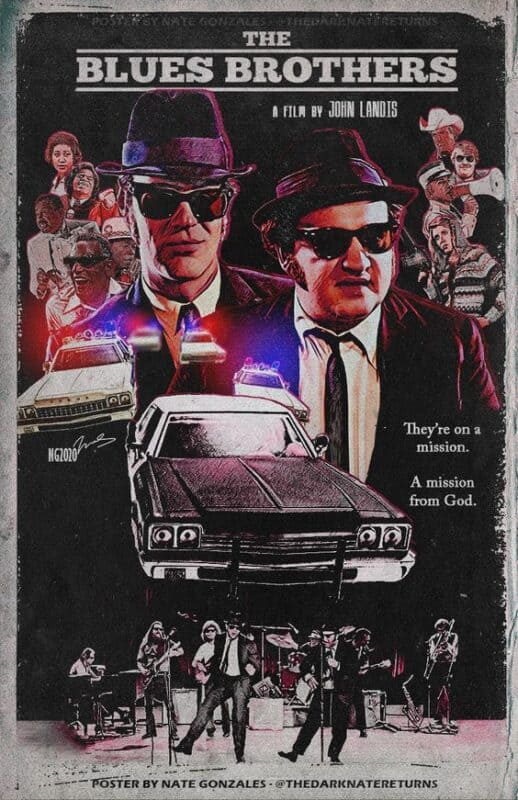
Source: posterspy.comm / Pinterest
Directed by John Landis, this musical comedy features John Belushi and Dan Aykroyd as Jake and Elwood Blues. They embark on a mission from God to save their childhood orphanage by reuniting their R&B band.
It’s an uproarious adventure that has become one of the best films of the 1980s. This film is a standout example of a black comedy, infusing humorous elements into a story with serious undertones.
Beyond its comedic brilliance, “The Blues Brothers” is renowned for its spectacular car chases, featuring iconic scenes of vehicular mayhem through the streets of Chicago.
Despite initial negative reviews from some critics, “The Blues Brothers” has endured as an iconic movie of the 1980s, beloved by audiences for its irreverent humor and infectious musical spirit.
In retrospect, “The Blues Brothers” represents more than just a film; it’s a testament to the creative spirit of the era, reflecting the cultural zeitgeist and leaving an enduring legacy in the annals of American film history.
Its impact continues to resonate, inspiring future filmmakers and music enthusiasts.
Beetlejuice (1988)
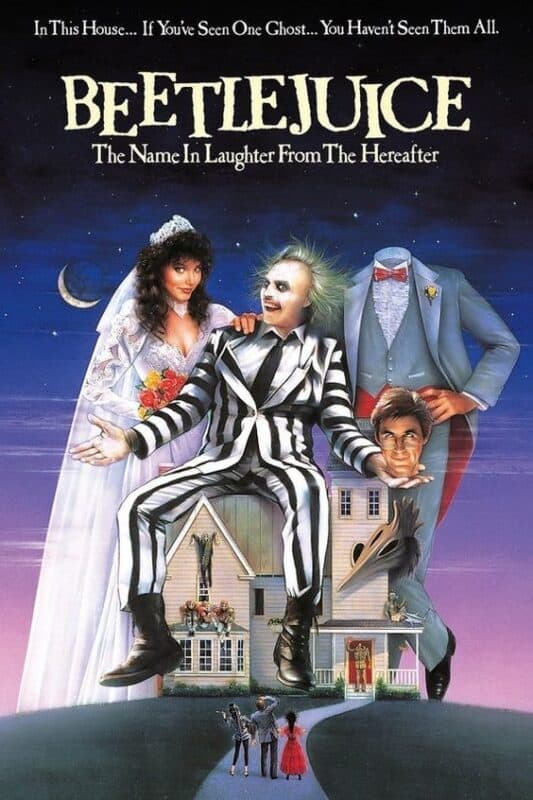
Source: etsy.com / Pinterest
Directed by Tim Burton, this dark comedy fantasy stars Michael Keaton as Beetlejuice, a mischievous “bio-exorcist” summoned by a recently deceased couple to frighten away the new occupants of their home.
With Burton’s signature style and quirky humor, this film has become a cult favorite among fans of young woman and young boy characters alike. His imaginative world-building and Gothic aesthetics are on full display in “Beetlejuice,” from the surreal depiction of the afterlife to the quirky designs of the supernatural characters.
The film’s darkly comedic tone and unconventional storytelling resonate with audiences, making it a cult favorite among fans of Burton’s work.
The film’s success at the box office solidified it as a highest grossing film of its time, showcasing the enduring appeal of Burton’s unique vision and the charm of Beetlejuice himself.
With its memorable characters, imaginative world-building, and irreverent humor, “Beetlejuice” continues to captivate audiences and inspire new fans.
Dirty Dancing (1897)

Source: seventeen.com / Pinterest
Directed by Emile Ardolino, this romantic drama set in the summer of 1963 follows Frances “Baby” Houseman, a young woman who discovers love with her dance instructor, Johnny Castle, at a resort. This film became a cultural sensation and remains one of the highest-grossing films of its time.
“Dirty Dancing” struck a chord with audiences upon its release, becoming one of the highest-grossing films of its time and leaving an indelible mark on popular culture. The film’s success catapulted director Emile Ardolino into the spotlight, showcasing his ability to craft heartfelt stories that resonate with audiences.
As a filmmaker, Ardolino captures the essence of youthful ambition and the transformative power of love. “Dirty Dancing” transcends its romantic narrative to explore themes of class, identity, and empowerment, resonating with viewers of all ages.
Set against the backdrop of the 1960s, “Dirty Dancing” paints a vivid picture of a bygone era, celebrating the time’s music, fashion, and social dynamics. The film’s iconic soundtrack, featuring hits like “(I’ve Had) The Time of My Life” and “Hungry Eyes,” adds depth and emotion to Baby and Johnny’s blossoming romance.
“Dirty Dancing” remains a beloved classic in cinema, cherished for its infectious energy, memorable performances, and timeless storytelling.
Emile Ardolino’s directorial vision brought Baby and Johnny’s love story to life and captivated audiences with their dance-filled journey of self-discovery and passion.
Raiders of the Lost Ark (1981)

Source: cinemaclock / Pinterest
“Raiders of the Lost Ark” (1981), directed by Steven Spielberg, is a landmark action-adventure film that defined the genre and introduced audiences to the iconic character of Indiana Jones, portrayed by Harrison Ford.
Set in the 1930s, the film follows the archaeologist as he races against time to locate the legendary Ark of the Covenant before it falls into the hands of the Nazis.
Steven Spielberg’s masterful direction and George Lucas’s imaginative storytelling combined to create a cinematic experience that resonated with audiences worldwide. “Raiders of the Lost Ark” became a cultural phenomenon upon its release, setting box office records and solidifying its place as one of the highest grossing films of the 1980s.
The film’s thrilling action sequences, including the iconic opening scene in the Peruvian jungle and the harrowing chase through the streets of Cairo, set a new standard for action movies.
“Raiders of the Lost Ark” is a groundbreaking feature film and one of the greatest films in cinematic history. Its enduring popularity and critical acclaim have cemented its legacy as a timeless classic that continues to captivate audiences of all ages.
This film marked the first installment in the Indiana Jones franchise, spawning sequels and solidifying Indiana Jones as one of cinema’s most beloved characters.
“Raiders of the Lost Ark” remains a shining example of blockbuster filmmaking. It blends thrilling action, compelling characters, and a sense of adventure that continues to resonate with audiences decades after its release.
Back to the Future (1985)
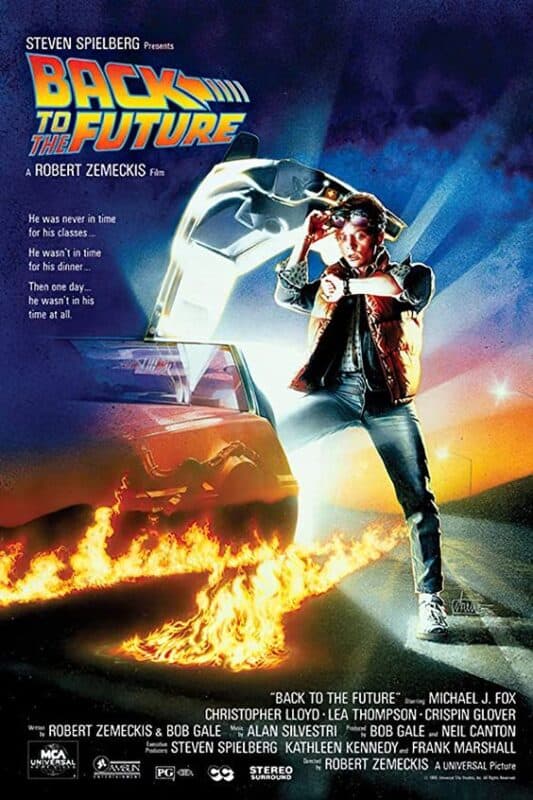
Source: amazon.com / Pinterest
Directed by Robert Zemeckis, “Back to the Future” is a beloved sci-fi comedy that follows young Marty McFly (Michael J. Fox) on an unexpected journey through time.
When Marty accidentally travels back to 1955 in a DeLorean time machine created by his eccentric friend, Doc Brown, he must navigate the challenges of altering the past to secure his own future.
This film became one of the highest-grossing films of the 1980s, captivating audiences with its clever premise and endearing characters.
Robert Zemeckis’ direction masterfully blends humor, adventure, and heart, creating an unforgettable cinematic experience that continues to resonate with audiences worldwide.
“Back to the Future” remains a timeless classic that captures the imagination by exploring time travel and the consequences of altering history.
E.T. the Extra-Terrestrial (1982)
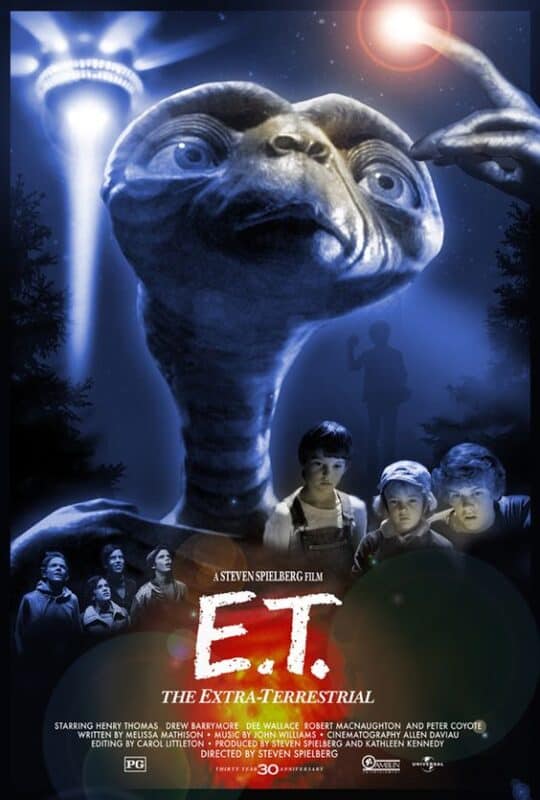
Source: soundonsight.org / Pinterest
Again, directed by Steven Spielberg, “E.T. the Extra-Terrestrial” is a heartwarming tale about a young boy named Elliot who befriends a stranded alien creature and helps him find his way home.
This touching story beautifully captures the innocence and wonder of childhood, resonating with audiences of all ages.
Steven Spielberg’s direction infuses the film with emotion and depth, emphasizing the themes of friendship, empathy, and belonging.
“E.T. the Extra-Terrestrial” became one of the highest-grossing films of its time, captivating audiences with heartfelt narrative and memorable performances.
The Breakfast Club (1985)
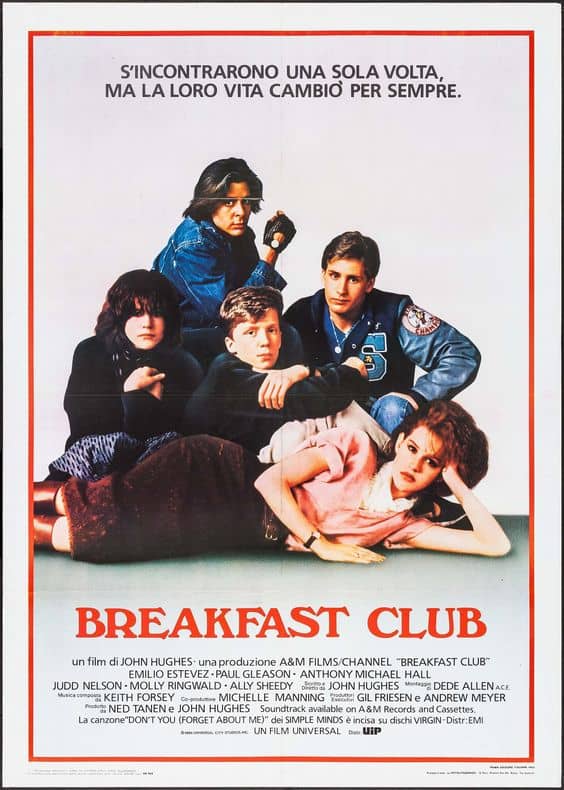
Source: movieposters.ha.com / Pinterest
Directed by John Hughes, “The Breakfast Club” is an iconic teen drama that brings together a diverse group of high school students during Saturday detention.
As students from different social cliques confront their differences and discover unexpected connections, the film explores adolescence, identity, and societal expectations.
John Hughes’ direction and authentic storytelling elevate “The Breakfast Club” beyond typical teen films. It resonates with audiences by delving into universal themes of acceptance and self-discovery.
To this day, the film remains a cultural touchstone.
These films exemplify the creativity and storytelling prowess of the 1980s, each leaving an indelible mark on cinema and captivating audiences with their timeless narratives and unforgettable characters.
Conclusion
It’s time to summarize everything from today’s brief lesson on the film released in the 1980s.
These films represent a transformative era in cinema characterized by groundbreaking storytelling, iconic characters, and unforgettable narratives.
This decade saw the rise of blockbuster entertainment, with films like “Raiders of the Lost Ark” and “Top Gun” setting new standards for action and adventure. Directors like Steven Spielberg and John Hughes redefined popular culture with their innovative vision, introducing audiences to beloved characters like Indiana Jones and the memorable teens of “The Breakfast Club.”
Paramount Pictures emerged as a powerhouse studio during this time, producing some of the highest-grossing films of the era, including “Top Gun” and “Raiders of the Lost Ark.” New York City served as a vibrant backdrop for many iconic scenes, reflecting the energy and diversity of the decade.
The 1980s marked the debut of many young actors who would go on to become major stars, such as Tom Cruise in “Top Gun” and Michael J. Fox in “Back to the Future.” These films not only entertained audiences but also captured the spirit of a generation grappling with societal changes and the aftermath of World War II.
The influence of first films released in the 1980s were produced by Paramount Pictures and set against the backdrop of New York City. The highest-grossing films of this era, including action-packed blockbusters and heartfelt dramas, continue to resonate with audiences today, showcasing the enduring impact of visionary directors and the timeless appeal of compelling storytelling.
No matter if you’re experiencing these classics for the first time or revisiting them to relive the magic of cinematography, one thing’s certain – these iconic films capture the essence of a transformative era in cinema.
So, if you’re a fan of old-school blockbusters or you liked some of the films I’ve recommended, go ahead!
